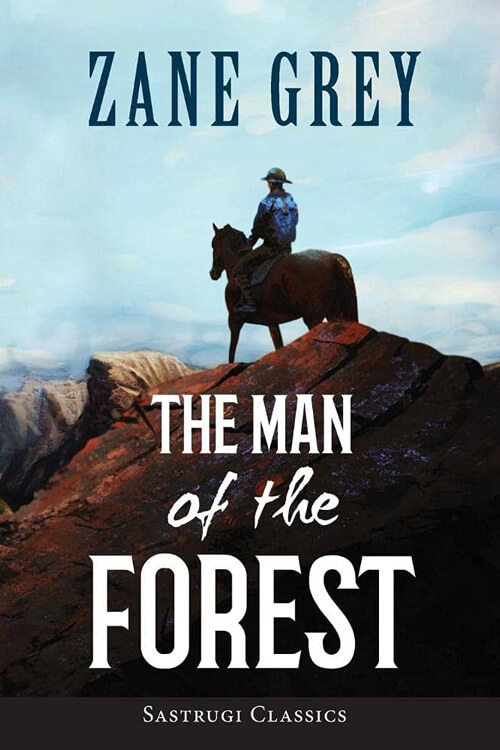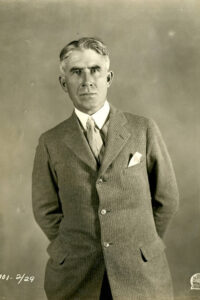
The Man of the Forest
At sunset hour the forest was still, lonely, sweet with tang of fir and spruce, blazing in gold and red and green; and the man who glided on under the great trees seemed to blend with the colors and, disappearing, to have become a part of the wild woodland.
Old Baldy, highest of the White Mountains, stood up round and bare, rimmed bright gold in the last glow of the setting sun. Then, as the fire dropped behind the domed peak, a change, a cold and darkening blight, passed down the black spear-pointed slopes over all that mountain world.
It was a wild, richly timbered, and abundantly watered region of dark forests and grassy parks, ten thousand feet above sea level, isolated on all sides by the southern Arizona desert — the virgin home of elk and deer, of bear and lion, of wolf and fox, and the birthplace as well as the hiding-place of the fierce Apache.
September in that latitude was marked by the sudden cool night breeze following shortly after sundown. Twilight appeared to come on its wings, as did faint sounds, not distinguishable before in the stillness.
Milt Dale, man of the forest, halted at the edge of a timbered ridge, to listen and to watch. Beneath him lay a narrow valley, open and grassy, from which rose a faint murmur of running water. Its music was pierced by the wild staccato yelp of a hunting coyote. From overhead in the giant fir came a twittering and rustling of grouse settling for the night; and from across the valley drifted the last low calls of wild turkeys going to roost.
To Dale’s keen ear, these sounds were all they should have been, betokening an unchanged serenity of forestland. He was glad, for he had expected to hear the clip-clop of white men’s horses — which to hear up in those fastnesses was hateful to him. He and the Indian were friends. That fierce foe had no enmity toward the lone hunter. But there hid somewhere in the forest a gang of bad men, sheep-thieves, whom Dale did not want to meet.
Read or download Book
Zane Grey
Pearl Zane Grey (January 31, 1872 – October 23, 1939) was an American author and dentist. He is known for his popular adventure novels and stories associated with the Western genre in literature and the arts; he idealized the American frontier. Riders of the Purple Sage (1912) was his best-selling book.
In addition to the success of his printed works, his books have second lives and continuing influence adapted for films and television. His novels and short stories were adapted into 112 films, two television episodes, and a television series, Dick Powell’s Zane Grey Theatre.
Biography
Early life
Pearl Zane Grey was born on January 31, 1872, in Zanesville, Ohio. His birth name may have originated from newspaper descriptions of Queen Victoria’s mourning clothes as “pearl grey”. He was the fourth of five children born to Alice “Allie” Josephine Zane, whose English Quaker immigrant ancestor Robert Zane came to the American colonies in 1673, and her husband, Lewis M. Gray, a dentist. His family changed the spelling of their last name to “Grey” after his birth. Grey later dropped “Pearl” and used “Zane” as his first name.
Grey grew up in Zanesville, a city founded by his paternal grandfather Benjamin Zane’s brother-in-law, John McIntire (husband of Sarah Zane), who had been given the land by Grey’s maternal great-grandfather, Ebenezer Zane, an American Revolutionary War patriot.
Both Grey and his brother Romer were active and athletic boys who were enthusiastic baseball players and fishermen. From an early age, he was intrigued by history. Soon, he developed an interest in writing. His early interests contributed to his later writing success. For example, his knowledge of history informed his first three novels, which recounted the heroism of ancestors who fought in the American Revolutionary War.
As a child, Grey frequently engaged in violent brawls, probably related to his father’s punishing him with severe beatings. Though irascible and antisocial like his father, Grey was supported by a loving mother and found a father substitute. Muddy Miser was an old man who approved of Grey’s love of fishing and writing, and who talked about the advantages of an unconventional life. Despite warnings by Grey’s father to steer clear of Miser, the boy spent much time during five formative years in the company of the old man.
Grey was an avid reader of adventure stories such as Robinson Crusoe and the Leatherstocking Tales, as well as dime novels featuring Buffalo Bill and Deadwood Dick. He was enthralled by and crudely copied the great illustrators Howard Pyle and Frederic Remington. He was particularly impressed with Our Western Border, a history of the Ohio frontier that likely inspired his earliest novels. Grey wrote his first story, Jim of the Cave, when he was fifteen. His father tore it to shreds and beat him.
Because of the shame he felt as the result of a severe financial setback in 1889 due to a poor investment, Lewis Grey moved his family from Zanesville and started again in Columbus, Ohio. While his father struggled to re-establish his dental practice, Grey made rural house calls and performed basic extractions, which his father had taught him. The younger Grey practiced until the state board intervened. His brother Romer earned money by driving a delivery wagon. Grey also worked as a part-time usher in a theater and played summer baseball for the Columbus Capitols, with aspirations of becoming a major leaguer. Eventually, Grey was spotted by a baseball scout and received offers from many colleges. Romer also attracted scouts’ attention and went on to have a professional baseball career.






